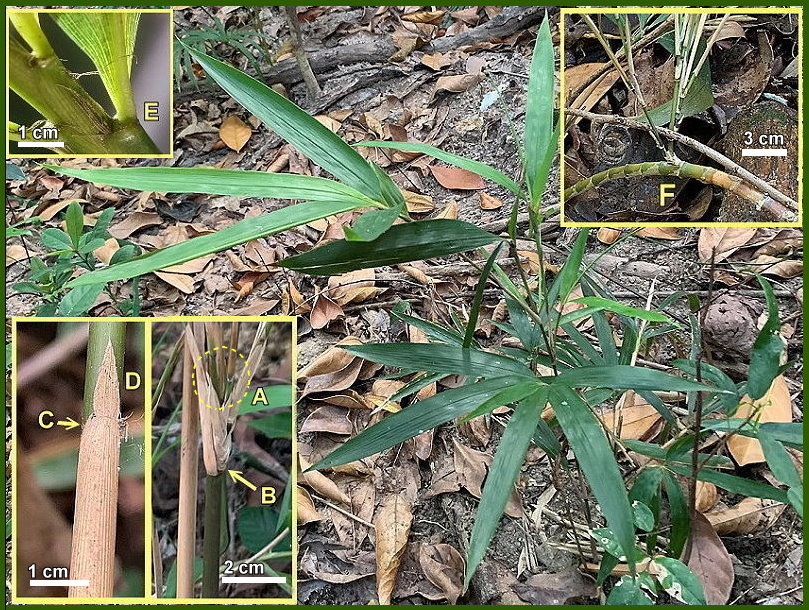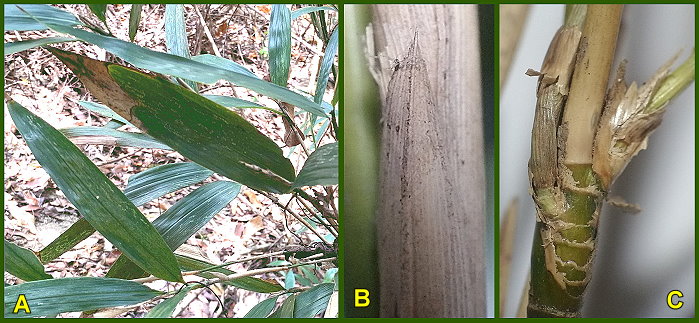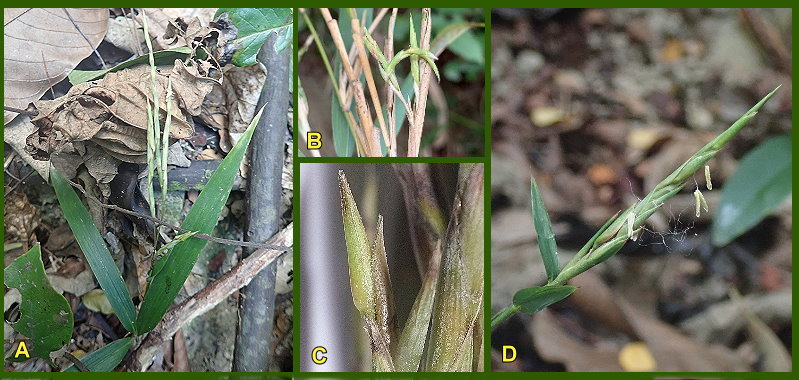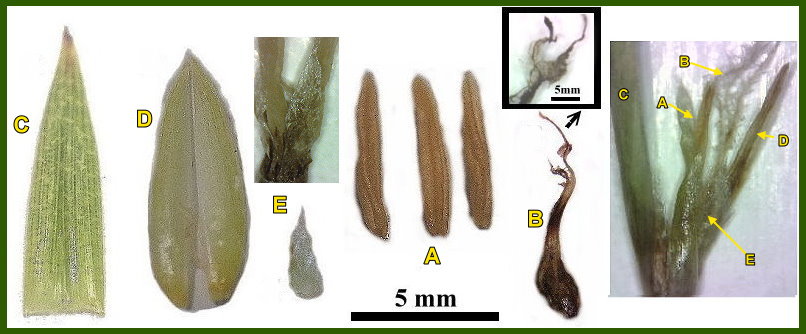|
Rearrangement of the Genera of a Hong
Kong endemic species, Subglabrous dwarf bamboo 'Sasa subglabra
McClure'
Owen et E.Ng
20th May, 2021.
CHINESE VERSION
Summary:
Sasa subglabra
McClure was collected and determinated on 1938, this Hong Kong
endemic flora as an uncertain species due to insufficient scientific
evidences, although many botanists have doubts about its genus of
Sasa, based on the lack of the flowering specimens, the
taxonomic characteristics are still not clear. Fortunately, we
accidentally discovered that few of the mature plants were blooming
during field visits in the end-spring season of this year,
it is believed that this discovery may led to
unlock the secret of the systematic position of this endemic species,
this article also provides information on the inflorescences of the
species.
Key words: Sasa subglabra
McClure sensu lato, Indocalamus subglabra
(McClure) Ng et al., 2021,Genus: Sasa, Genus:
Indocalamus, Lateral panicles.
Habitat:
Sha Tin, Central New Terroritries, HONG KONG, only one spot in forest, partially
shaded slope near ravine area, ca. 11,300m2 (121,600 ft2).
Discussion of the genera of this species: Shrubby running bamboos,
they contains the number of branches on the node are usually single branch,
sometimes 2
branches is the most and small amount of 3 branches at the secondary branches,
and the culm nodes are uplifted at the attachment of the sheath, the
ciliata on the shoulder disappear when mature, which are obviously incompatible
with genus Sasa. The vegetative leaves of this species are huge, the
culms are thin, and the plants are always short. In the habitat, they are mostly
attached to the tall shrubs and are sparsely existing and unable to form a
bamboo forest. It is far away from the genera: Arundinaria and
Psedudosasa. Because the maximum height of this species is not taller than 2
meters, open type vascular bundles found from the the cross section of the culm.
The floret of this species has greenish lemmas, yellowish-white stamens, 3
stamens, yellowish anthers, and inflorescences in panicles. In addition,
morphological structure of the vegetative leaf are also closely related to
the genus Indocalamus, therefore, it is recommended to be included in of
this category.
In order to respect
the previous sages who studied this species, the author suggests to retain the
original Chinese name (光笹竹) and add a descriptive name (香港箬竹) to supplement the
sparseness.
Taxonomic position of Indocalamus
subglabra (McClure) Ng et al., 2021, genera rearrangement
PHYLUM MAGNOLIOPHYTA
● Class Liliopsida
● Subclass: Commelinidae
● Order: Cyperales
● Family: Poaceae
● Supertribe: Arundinariatae
● Subtribe: Sasinae
●
Genus: Indocalamus
Fig. I: Indocalamus
subglabra (McClure) Ng et al., 2021 (drawn
by
Cognitio Sapiens Ngensis)
1. portion of culm, 2. sheath proper, 3. blade,
4. cross section of culm, 5. leaf,
6. enlargement of partial vein , 7. Panicle flowering branchlet,
8. foret,
9. stamens,
10. pistil,
11. lodicule, 12. lemma,
13. palea
光笹竹(香港箬竹) Indocalamus subglabra (McClure) Ng et al., 2021,
genera rearrangement,
Synonym: Sasa subglabra McClure,
Lingnan University Science Bulletin, 9: 45 1940, Hong Kong Bamboos, P.75,
1985, Flora of China, V9(1): P.674, 1996, Flora of
Guangdong, V9: P.291, 2009, Flora of Hong Kong, V4: P.142-143,
2011.
Digital images of holotype specimen examined:
barcode 00141340, 00065443, topotype specimens: barcode 00305601~
00305604, Coll. No. 21251, by H. Fung,
03 V 1938, US National Herbarium specimen, by Smithsonian
Institution.
Voucher specimens: NSF-3581835, NSF-3581835(A)~(E),
Acta Scientium Ngensis.

Fig. II: Indocalamus subglabra (McClure) Ng et al.,
2021 in wild

Fig. III: Indocalamus subglabra (McClure) Ng et al.,
2021 typical A. vegetative leaf, B. Culm sheath, C. branches
Perennial, shrubby bamboo, culms erect,
smoothly, 40cm~ 200cm tall, 5-1.5mm in diameter, lateral branches
suffrutescent, branches usually 1(commonest, fig III: C) to 3 (rarely) at upper nodes (Fig II: A), internodes terete, always 10-20cm long. Culm nodes are uplifted at the attachment of the
sheath (Fig II: B), Culm-sheaths persistent, minute ciliolate when young (Fig
II: C), sheaths tightly culm clasping, without auricles when mature, Culm-sheath
blade linear; erect (Fig II: D). Vegetative leaf (fig III: A) in grassy-grennish color, oval
to oblong-lanceolate, 10-30cm long, 2-6cm wide, shorty ciliolate towards
beneath, without auricles, 12-18 veins impressed adaxially and
prominent abaxially, mid-viens are particularly wide and obvious.
Rhizomes (Fig II: F) elongated, sympodium.

Fig. IV: Indocalamus subglabra (McClure) Ng et al., 2021
, flowering branchlet

Fig. V: Indocalamus subglabra (McClure) Ng et al., 2021
, anatomical view of a floret
Lateral panicles (Fig
IV: A~D), dense arranged, ranging from 4 to 10 cm in length, floret 8-12 mm long,
lemma (picture IV: C) grassy-greenish in color, 10 mm high when mature, palea (Fig IV: D)
Yellowishish-white, 75 mm high when mature, lodicule (Fig. V: E) lanceolate,
silvery white, average 1.3 to 2 mm in height , pistil with 3 stigma (Fig. V:
B), about 3 mm long, white , Purple-black when mature, 3 stamens (Fig. V: A), 3
to 4 mm long, 0.5 to 1 mm wide, yellowish-green when immature, and orange-yellow
when mature. The ovary is underdeveloped; the florets in the withered
inflorescence are aborted, the seeds: not seen.
Acknowledgment
The flowering of
bamboo is a relatively rare phenomenon. Because of the different species, the
flowering period can exceed a century, and then the next flowering period will
be ushered in. For this species, no one cannot predict its next flowering period,
we hope this population to be able to bloom again, they can survive the challenge
of survival and keep on living in Hong Kong.
We wish to express our the deepest gratitude to Professor Floyd Alonzo McClure
(1894-1970).
References
[1] Department of Botany, Smithsonian
Instituton, https://naturalhistory.si.edu/research/botany
[2] Hong Kong Bamboos, But,
Paul Pui-Hay; Chia, Liang-chi; Fung, Hok-lam; Hu, Shiu-Ying, Published by Urban
Council, Hong Kong, 1985
[3] Flora of Hong Kong, Vol. 4, AFCD,
2011/04.
[4]《中國竹亞科屬種檢索表》, 易同培 等 編著, 科學出版社, 2009/08.
[5] Rare and Precious Plant of Hong Kong,
Hu Qi-ming et al., AFCD, 2003/10.
[6] Flora of China, Chinese version,
Vol.9(1):
Poaceae , 耿伯介 王正平, 科學出版社, 1996. |